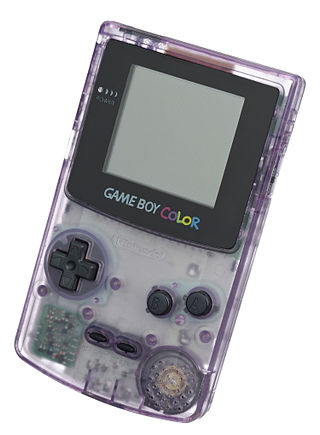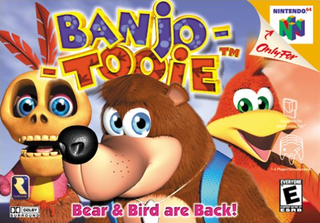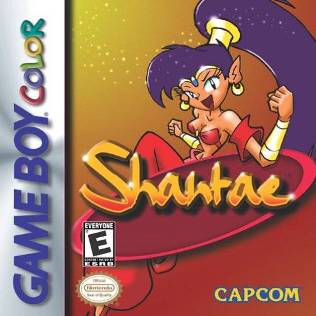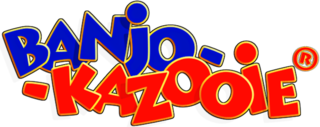Related Research Articles

The Game Boy Color is an 8-bit handheld game console, manufactured by Nintendo, which was released in Japan on October 21, 1998 and to international markets that November. It is the successor to the Game Boy and is part of its product line. Critics like IGN consider it more akin to a hardware revision than a next generation product.

Mario Tennis is a 2000 sports video game developed by Camelot Software Planning and published by Nintendo for the Nintendo 64. Following Mario's Tennis, it is the second game in the Mario Tennis series. The game is known for being the introduction of Luigi's arch-rival, Waluigi, and the re-introduction of Princess Daisy and Birdo.

Donkey Kong 64 is a 1999 platform game developed by Rare and published by Nintendo for the Nintendo 64. It is the only Donkey Kong game to feature 3D gameplay. As the gorilla Donkey Kong, the player explores themed levels to collect items and rescue his kidnapped family members from King K. Rool. The player completes minigames and puzzles as five playable Kong characters—each with their own special abilities—to receive bananas and other collectibles. In multiplayer modes, up to four players can compete in deathmatch and last man standing games.

Rare Limited is a British video game developer and a studio of Xbox Game Studios based in Twycross, Leicestershire. Rare's games span the platform, first-person shooter, action-adventure, fighting, and racing genres. Its most popular games include the Battletoads, Donkey Kong, and Banjo-Kazooie series, as well as games like GoldenEye 007 (1997), Perfect Dark (2000), Conker's Bad Fur Day (2001), Viva Piñata (2006), and Sea of Thieves (2018).

Banjo-Kazooie is a 1998 platform game developed by Rare and published by Nintendo for the Nintendo 64. Controlling the player characters, the bear Banjo and the bird Kazooie, the player attempts to save Banjo's kidnapped sister Tooty from the witch Gruntilda. The player explores nine nonlinear worlds to gather items and progress. Using Banjo and Kazooie's traversal and combat abilities, they complete challenges such as solving puzzles, jumping over obstacles, and defeating bosses.

Banjo-Tooie is a platform video game developed by Rare and originally released for the Nintendo 64 console in 2000. It is the second game in the Banjo-Kazooie series and the sequel to Banjo-Kazooie. The game follows the returning protagonists Banjo and Kazooie as they attempt to stop the plans of the witch Gruntilda and two of her sisters, who intend to vaporise the inhabitants of the game's island setting. The game features worlds significantly larger than those of its predecessor, requiring the player to complete challenges such as solving puzzles, jumping over obstacles, collecting items, and defeating opponents. It also includes a multiplayer mode in which up to four players can compete in several minigames repurposed from the main campaign.

Donald Duck: Goin' Quackers is a platform video game developed and published by Ubi Soft for various consoles and Windows-based personal computers. A different game with the same title was first released for the Game Boy Color, as well as on Game Boy Advance, the latter being given the title Donald Duck Advance.

The Game Boy Camera, released as Pocket Camera in Japan, is a Nintendo accessory for the handheld Game Boy game console. It was released on February 21, 1998, in Japan, and manufacturing was ceased in late 2002. As a toy for user-generated content, it can be used to shoot grayscale photographs, edit them or create original drawings, and transfer images between GBC units or to the 64DD art game suite Mario Artist. The accessory featured a 180°-swivel front-facing camera that allowed users to capture selfies. Its images can be printed to thermal paper with the Game Boy Printer. The GBC's cartridge contains minigames based on Nintendo's early games such as the arcade video game Space Fever and the Game & Watch handheld game Ball, and a chiptune music sequencer; photographers have embraced its technological limitations as artistic challenges.

The Transfer Pak is a removable accessory for the Nintendo 64 controller that fits into its expansion port. When connected, it allows for the transfer of data between supported Nintendo 64 (N64) games and Game Boy or Game Boy Color (GBC) games. By using the Transfer Pak, players can unlock additional content in compatible games; the Pokémon Stadium games, with which the Transfer Pak was initially bundled for sale, also feature the ability to emulate specific Game Boy Pokémon titles for play on the N64.

Banjo-Kazooie: Grunty's Revenge is a 2003 platform game by Rare for Nintendo's Game Boy Advance (GBA). It is the third instalment in the Banjo-Kazooie series and takes place between the events of the Nintendo 64 (N64) games Banjo-Kazooie (1998) and Banjo-Tooie (2000). In Grunty's Revenge, the evil witch Gruntilda travels back in time to prevent the events of Banjo-Kazooie from happening, and the bear Banjo and his bird friend Kazooie set out to stop her. Grunty's Revenge retains the focus on collecting items and most of the other game mechanics from its predecessors, but is presented in 2D rather than 3D. Aside from the main game, players can also access minigames such as fishing and target shooting.

Shantae is a platform video game developed by WayForward and published by Capcom for the Game Boy Color in 2002. It is the first title in the Shantae series. The game follows the adventures of the eponymous half-genie Shantae, who must travel across Sequin Land, the setting of the series, to foil the domination plans of the evil lady pirate Risky Boots. During her quest, she learns various dances and acquires items which make her progressively stronger as well as unlocking new abilities and locations, leading her to ultimately face off against Risky in her hideout.

Banjo-Kazooie is a series of video games developed by Rare. The games feature a male bear named Banjo and his friend, a large female red bird named Kazooie, who are both controlled by the player. Banjo originally made his debut as a playable character in 1997 as part of the cast of Diddy Kong Racing. Throughout the various games, they are tasked with thwarting the various evil schemes of a witch named Gruntilda. The first game, Banjo-Kazooie, was released in 1998 to critical acclaim and was followed by three sequels and a spin-off racing game.

Banjo-Kazooie: Nuts & Bolts is a 2008 platform game developed by Rare and published by Microsoft Game Studios for the Xbox 360. Set eight years after Banjo-Tooie (2000), Nuts & Bolts follows the bear-and-bird duo Banjo and Kazooie as they compete with the witch Gruntilda for ownership of their home. Although Nuts & Bolts retains the structure of previous Banjo-Kazooie games—collecting jigsaw puzzle pieces to progress—it shifts the focus from exploration to vehicle construction. The player designs vehicles, including automobiles, boats, and aeroplanes, and uses them to complete challenges across various worlds. In multiplayer modes, players can compete or share their vehicles over Xbox Live.
Perfect Dark is a science-fiction video game series created by Rare and owned by Xbox Game Studios. It debuted in 2000 with the release of the Nintendo 64 first-person shooter Perfect Dark. The series follows Joanna Dark, an agent of the Carrington Institute agency, as she uncovers conspiracies by rival corporation dataDyne. In addition to video games, the series has expanded into novels and comics. These supplements to the video games have resulted in a significant development of the series' fictional universe.

Project Dream was the codename of a role-playing video game (RPG), Dream: Land of Giants, that served as the basis for the 1998 game Banjo-Kazooie. Developed by Rare, it was aimed for release on the Super Nintendo Entertainment System (SNES), and later the Nintendo 64 (N64). The plot followed a young boy, Edson, who caused trouble with pirates. The SNES version of Dream used an isometric perspective and had a fairy tale theme. After transitioning to the N64, the project became a more complex 3D RPG that had a greater emphasis on the pirate theme. Eventually, Dream was scaled back to a linear platform game in the vein of Donkey Kong Country (1994) that starred Banjo the bear, who became the protagonist of Banjo-Kazooie.

Banjo-Pilot is a 2005 kart racing video game for the Game Boy Advance (GBA) and the fourth instalment in Rare's Banjo-Kazooie series. It plays similarly to the Mario Kart series by Nintendo: the player races one of nine playable characters around tracks, attacking other racers with bullets and collecting power-ups. The game features a number of single-player and multiplayer modes, such as time attack and item hunts. Unlike other kart racing games, characters control airplanes instead of go-karts.

The Mummy, known in Japan as Hamunaptra: Ushinawareta Sabaku no Miyako, is a single-player video game for Game Boy Color, PlayStation and Microsoft Windows, based on the 1999 movie of the same name. It was published by Konami.

Banjo & Kazooie are a pair of fictional video game characters and the eponymous protagonists of the video game series Banjo-Kazooie, created by British video game developer Rare. Banjo and Kazooie were both introduced as player characters in the original Banjo-Kazooie (1998). Banjo is a honey bear who is accompanied by Kazooie, a bird who is often seen seeking shelter in Banjo's backpack and emerging to perform various moves and attacks. The pair's numerous adventures usually pit them against the evil witch Gruntilda.
References
- ↑ "Plans For Cancelled Game Boy Color Banjo Kazooie Uncovered". Game Informer . October 5, 2015. Retrieved July 15, 2018.[ dead link ]
- ↑ "Lost Game Boy Color Banjo-Kazooie Game Unearthed In Design Documents". carmageddon.com. Stainless Games Inc. October 5, 2015. Archived from the original on August 18, 2012. Retrieved May 17, 2018.
- ↑ "Bandicoot Crashes the Game Boy Advance". ign.com. Ziff Davis LLC. September 21, 2000. Retrieved May 17, 2018.
- ↑ "The Making of The Game Band Brothers". n-sider.com. N-Sider Media. February 28, 2005. Retrieved May 17, 2018.
- ↑ "Interviews: Nintendo/TOSE - The Legendary Starfy". nintendolife.com. Nlife Media. May 22, 2009. Retrieved May 17, 2018.
- ↑ "Capcom Had Two Game Boy Color Versions Of Dino Crisis In Development, But Cancelled Both". nintendolife.com. Nlife Media. March 9, 2015. Retrieved May 17, 2018.
- ↑ "Round Up: Final Fantasy XII, Diner Dash, Punch/Walsh". IGN . September 15, 2000. Archived from the original on February 23, 2001. Retrieved May 19, 2018.
- ↑ I. G. N. Staff (2001-12-01). "Raylight Shines on Game Boy Advance". IGN. Retrieved 2023-09-26.
- ↑ "Gekido GB Color". napsteam.com. N.A.P.S. Team snc. Archived from the original on July 28, 2001. Retrieved May 17, 2018.
- ↑ "『トマトアドベンチャー』開発者インタビュー". Nintendo Online Magazine (Nintendo). January 2002. Retrieved November 10, 2007.
- ↑ "See The Opening Moments Of The Jet Force Gemini Game Boy Color Game". Siliconera. 2016-01-26. Retrieved 2023-09-08.
- ↑ "KISS Psycho Circus: The Nightmare Child - IGN". IGN.com. IGN. Retrieved May 18, 2018.
- ↑ "Zelda's Tri-Force down to Two". IGN.com. IGN. July 24, 2000. Retrieved May 18, 2018.
- ↑ "Metroid - GBC". Club Nintendo . No. 77. April 1998. p. 15.
- ↑ "The (Almost) Making of Mythri". gamespite.net. May 12, 2008. Retrieved May 18, 2018.
- ↑ "NBA Live 2000 - IGN". IGN.com. IGN. Retrieved May 18, 2018.
- ↑ "Nintendo's Secrets Are Continuing to Leak, Revealing Its Unknown History". 11 September 2020.
- ↑ "HotGen tells us it's Incredible!". IGN.com. IGN. January 5, 2000. Retrieved May 18, 2018.
- ↑ "Rhino Rumble Puzzle". IGN. July 29, 2000. Archived from the original on December 21, 2020.
- ↑ "Midway - Consolemania". Consolemania . Vol. 8, no. 78. October 1998. p. 28.
- 1 2 3 "Game Boy Color - New Titles". Nintendo Power . No. 114. November 1998. p. 85.
- ↑ "Seadoo Hydrocross-GBC". vvisions.com. Archived from the original on May 5, 2001. Retrieved May 18, 2018.
- ↑ "A Very Small Thing". IGN.com. IGN. September 21, 2000. Retrieved May 18, 2018.
- ↑ "The Three Stooges for Game Boy Color". YouTube .
- ↑ "The PlayStation skateboarding title is on its way to Game Boy Color. Play while you thrash!". IGN.com. IGN. September 17, 1999. Retrieved May 18, 2018.
- ↑ "Tex's Rise and Fall". nintendoplayer.com. Retrieved May 18, 2018.